The Story of Tiddalik the Frog
Reading Time: 8 min
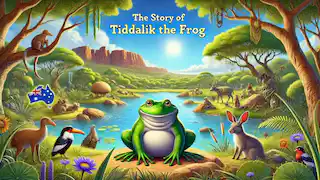
About Story: The Story of Tiddalik the Frog is a Folktale from australia set in the Ancient. This Simple tale explores themes of Nature and is suitable for All Ages. It offers Cultural insights. A captivating tale of a greedy frog and the clever animals who restore balance to their world.
Chapter 1: The Greedy Frog
Long ago, in the Dreamtime when the world was new, there lived a frog named Tiddalik. He was no ordinary frog, for Tiddalik was known for his enormous appetite and insatiable thirst. One particularly hot day, Tiddalik woke up feeling extremely thirsty. So thirsty, in fact, that he began to drink and drink, unable to stop himself. He drank all the water in the billabong, the rivers, and even the lakes until there was not a drop of water left in the land.
The animals of the bush began to suffer greatly without water. The kangaroos, the koalas, the emus, and all other creatures were desperate. They gathered in a council, hoping to find a solution to their dire predicament.
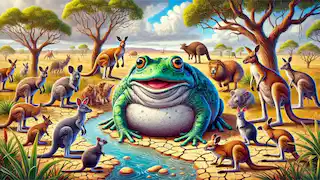
The elder of the council, a wise old wombat, said, “We must find a way to make Tiddalik laugh. Only then will he release the water he has consumed, and we can save our land.” The animals agreed, but the question remained: How could they make the greedy frog laugh?
Chapter 2: The Great Plan
The animals devised a plan. They decided to take turns performing tricks and antics, hoping that one of them would be funny enough to make Tiddalik laugh. The first to volunteer was the kookaburra, known for its loud and joyful laughter. The kookaburra perched on a branch near Tiddalik and began to laugh its loudest, most infectious laugh. But Tiddalik just stared, his large belly full of all the land’s water, without even a smile.
Next came the kangaroo. With its powerful legs and graceful hops, the kangaroo performed an impressive series of jumps and flips. It twisted and turned, hoping to amuse Tiddalik. But the frog remained unmoved, watching the performance with disinterest.
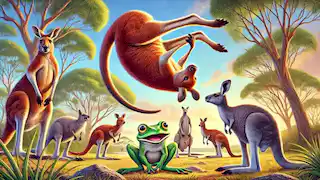
One by one, the animals tried their best. The emu danced with its long legs flailing, the echidna rolled into a ball and somersaulted around, and the possum swung from tree to tree in a daring display. But none of these antics could bring even a chuckle from Tiddalik. The animals were growing worried. If they couldn't make Tiddalik laugh, their land would remain dry, and they would all perish.
Chapter 3: The Wise Platypus
Just as hope was beginning to fade, the wise old platypus approached the council. Known for her intelligence and keen observations, the platypus suggested a different approach. “Perhaps,” she said, “we are trying too hard to make Tiddalik laugh. Maybe we need to show him the joy and beauty of the world he has deprived us of.”
The animals listened intently as the platypus explained her plan. Instead of performing tricks, they would recreate the vibrant scenes of their homeland, demonstrating to Tiddalik the life and happiness he had taken away. The animals agreed and began to work together, creating a grand display of their natural world.
Chapter 4: The Grand Display
The next day, the animals gathered around Tiddalik once more. This time, instead of tricks and antics, they presented a tableau of their lives before the water had disappeared. The parrots flew in colorful patterns, the kangaroos bounced gracefully, and the koalas climbed the tall eucalyptus trees, their movements slow and deliberate.
The wombats dug intricate burrows, showcasing their impressive digging skills, while the emus strutted proudly, their feathers shimmering in the sunlight. The platypus swam in a small puddle that was all that remained of their once vast rivers, her graceful movements a poignant reminder of the loss they all felt.
As Tiddalik watched, something began to stir within him. The beauty of the world, the harmony of the animals, and the sadness of their plight began to touch his heart. He felt a pang of guilt for what he had done.
Chapter 5: Nabunum's Turn
Seeing that Tiddalik was finally beginning to soften, the animals decided it was time for Nabunum, the clever eel, to try his trick. Nabunum had been watching from the water's edge, and he had an idea. He approached the council and said, “Let me try. I have a trick that might work.”
The animals, desperate and with nothing to lose, agreed. Nabunum slithered over to Tiddalik, who was lounging by the dry riverbed. The eel began to contort and twist his slippery body into all sorts of funny shapes. He tied himself into knots, twisted into loops, and even managed to form the shape of a circle.
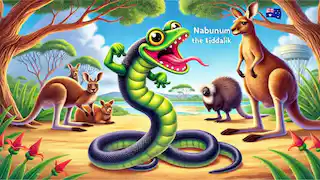
Tiddalik watched with mild curiosity. Nabunum then did something unexpected. He straightened his body and began to wiggle in the silliest way possible. His movements were so ridiculous that a small smile began to form on Tiddalik’s face. The other animals held their breath. Nabunum continued his antics, and finally, Tiddalik couldn’t hold back any longer. He burst into laughter, a deep, rumbling laugh that shook the ground.
Chapter 6: The Waters Return
As Tiddalik laughed, all the water he had swallowed began to gush out of his mouth and nose. It flowed back into the billabong, the rivers, and the lakes, restoring the precious water supply to the land. The plants began to flourish again, and the animals rejoiced, grateful for Nabunum’s cleverness.
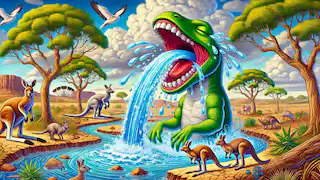
Tiddalik, though still a greedy frog, learned a valuable lesson that day. He realized the importance of sharing and the consequences of his actions. The animals, too, learned the power of cooperation and the importance of coming together in times of need.
The land, once parched and dry, was now vibrant and alive. The kangaroos hopped joyfully, the kookaburras laughed in the trees, and the waterholes were filled with life once more. The story of Tiddalik the frog was told and retold, a timeless reminder of the balance that must be maintained in nature.
Chapter 7: The Celebrations
The animals decided to celebrate the return of the water with a grand festival. They gathered around the now-full billabong and each contributed to the festivities in their own unique way. The kookaburras provided their cheerful laughter, echoing through the trees like a joyful chorus. The kangaroos held jumping competitions, their powerful leaps impressive and awe-inspiring.
The koalas, usually sleepy and reserved, danced slowly with each other, their movements filled with a gentle grace. The emus raced across the open plains, their speed and agility a marvel to behold. Even the echidnas and wombats joined in, playing games and enjoying the newfound abundance of water.
As the animals celebrated, they took a moment to thank Nabunum for his cleverness and bravery. Without his quick thinking and humorous performance, they might never have made Tiddalik laugh and saved their land.
Chapter 8: Tiddalik’s Reflection
Tiddalik watched the celebrations from a distance, feeling a mix of emotions. He was happy to see the animals enjoying themselves and the land flourishing once more. But he also felt a deep sense of remorse for his actions. He had nearly destroyed their world out of selfishness and greed.
Determined to make amends, Tiddalik approached the council of animals. “I am truly sorry for what I have done,” he said, his voice filled with sincerity. “I see now the harm I caused, and I want to make it right. From this day forward, I promise to share and never take more than I need.”
The animals were touched by Tiddalik’s apology and welcomed him back into their community. They knew that he had learned a valuable lesson and that their world would be a better place with Tiddalik as a friend rather than a foe.
Chapter 9: Lessons Passed On
Years passed, and the tale of Tiddalik became a legend among the animals. Elders would tell the story to the young ones, ensuring that the lesson of Tiddalik’s greed and the animals’ perseverance would never be forgotten. The billabongs and rivers remained full, and the animals never took their precious water for granted again.
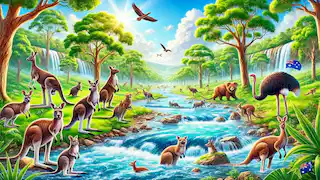
The story of Tiddalik also reached the ears of humans. The Aboriginal people of Australia shared the legend, passing it down through generations. They used it to teach their children about the importance of respecting nature and the dangers of greed.
Even today, the story of Tiddalik the frog is told in schools and around campfires, a testament to the wisdom of the Dreamtime. It serves as a powerful reminder of the delicate balance of the natural world and the role each creature plays in maintaining it.
Chapter 10: The Eternal Balance
In the heart of the bush, the animals continued to live in harmony, always remembering the lesson they learned from Tiddalik. They understood that each of them had a role to play in maintaining the balance of their world. They also realized that by working together and supporting one another, they could overcome any challenge.
The rivers flowed freely, the billabongs were teeming with life, and the land was lush and green. The animals thrived, knowing that their cooperation and respect for nature were the keys to their survival.
The story of Tiddalik the frog remained a cherished part of their culture, a symbol of the unity and resilience of the animal kingdom. And so, the legend lived on, inspiring generations to come to cherish and protect their precious world.

















